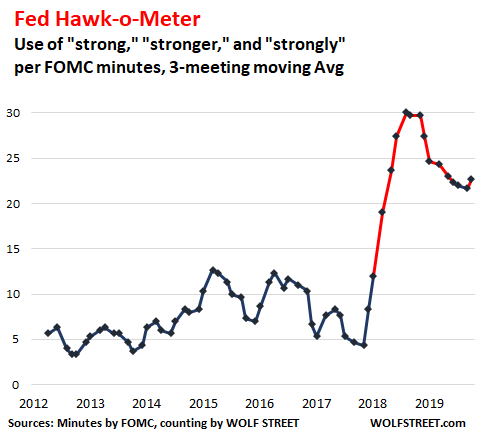Wolf Richter wolfstreet.com, http://www.amazon.com/author/wolfrichter
My Fancy-Schmancy “Fed Hawk-o-Meter”
The Fed has now moved into wait-and-see mode after cutting its policy rate for the third time in this cycle, this time to a range between 1.5% and 1.75%, while praising the “strong” labor market, which supports “strong” consumer spending, which is 70% of the economy. This is one of the key aspects that emerged from the minutes of its most recent meeting on October 29-30.
The Fed’s concern over trade tensions cannot be addressed with rate cuts anyway because rate cuts in the US are patently ineffective in inducing Chinese or German companies and consumers to buy US-made goods, and are equally ineffective in producing trade deals.
In theory, rate cuts might induce businesses to invest more – and business investment is one of the admitted weak points in the US economy at the moment – but rates faced by businesses were already low to begin with, and slightly lower rates won’t make a noticeable difference in decision making if businesses don’t see the need to invest, such as demand.
The weakness was in the industrial sector, including manufacturing, the meeting minutes pointed out. But consumer-facing businesses reported “strong demand.”
And so the FOMC meeting minutes came up with this wait-and-see statement (underscore added):
With regard to monetary policy beyond this meeting, most participants judged that the stance of policy, after a 25 basis point reduction at this meeting, would be well calibrated to support the outlook of moderate growth, a strong labor market, and inflation near the Committee’s symmetric 2 percent objective and likely would remain so as long as incoming information about the economy did not result in a material reassessment of the economic outlook.
This confirms what Fed Chair Jerome Powell had said in the post meeting press conference.
And it is showing up in my fancy-schmancy “Fed Hawk-o-Meter.” It analyzes the minutes for how the Fed sees the economy, by counting how often “strong,” “strongly,” and “stronger” appear in the minutes to describe the economy. For the October meeting, the Hawk-o-Meter rose 3 points (to 23), and importantly – ha, don’t take my Hawk-o-Meter too seriously – the three-month moving average ticked up for the first time since its down-movement started with the December meeting last year:

The words “strong,” “strongly,” and “stronger” appeared 24 times in the minutes of the October meeting. But one of them was a “false positive,” dealing with the purchases of Treasury bills and not the economy. So I removed it from the tally, leaving 23. This was up from 20 in the minutes for the September meeting.
The labor market was front and center of the Fed’s assessment of the strength of the economy, with 12 of the 23 counters of “strong” describing the labor market.
Some examples how “strong,” “stronger,” and “strongly” were used:
- “…that the labor market remained strong”
- “Real PCE [Personal Consumption Expenditures = consumer spending] rose solidly in the third quarter following a stronger gain in the second quarter.
- “…and stronger demand for the other CRE [Commercial Real Estate] lending categories.
- “The volume of agency and non-agency commercial mortgage-backed securities issuance was strong….”
- “…participants agreed that the labor market had remained strong over the intermeeting period”
- “…household spending had risen at a strong pace”
- “…participants agreed that consumer spending was increasing at a strong pace”
- “…supported by strong labor market conditions”
- “…business contacts in consumer-facing industries reported strong demand.
- “…business sentiment appeared to remain strong for some industries, particularly those most closely connected with consumer goods”
What Powell had called a “mid-cycle adjustment” at the meeting following the first rate cut has now apparently turned into a mid-cycle wait-and-see rather than a serial rate-cut binge.